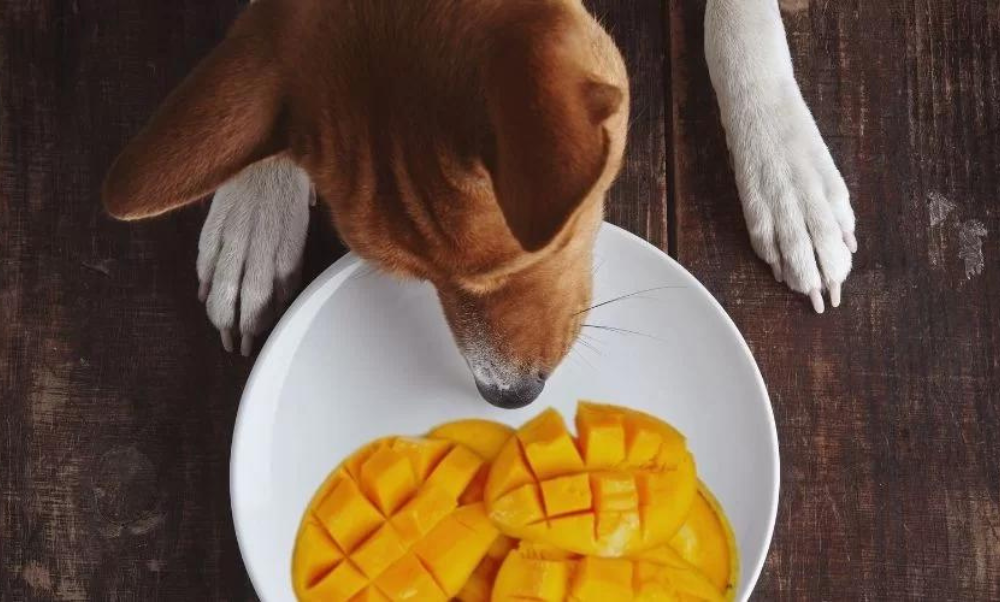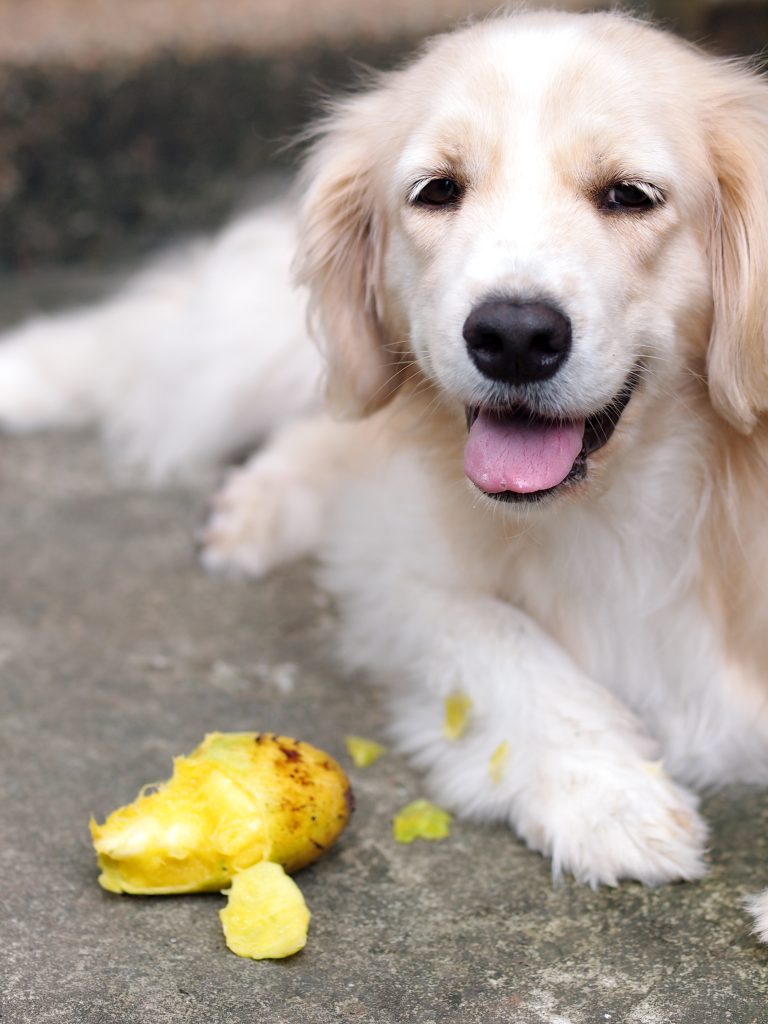Many dogs love the sweet taste that a piece of fruit offers, and tropical fruits such as the mango offer some seasonal variety to their diet. But, as with any human food, you need to know the dangers of feeding mango to your pup before you allow them this tasty treat.
Dogs can eat mango; this refreshing fruit offers several of the same benefits to canines as it does to humans. Still, not all parts of the mango fruit are safe for your furry friend, so you’ll need to put a little effort into preparing this treat so your pet can enjoy it alongside you.
Here’s everything you need to know about mangos and some of the best ways to prepare the treat for your pup.
Can Dogs Eat Mango?
On a hot summer’s day while enjoying a fresh, fruity treat you might find yourself asking, can dogs have mango? The good news is – yes, mangos are a safe food for dogs. Thanks to its sweet nature, it’s likely to be a treat that your dog will love. But not every part of a mango is suitable for your pup, so you’ll want to stick with the soft flesh. Like a range of other fruits, this is easy and safe for your dog to consume.
Is Mango Good For Dogs?
Mango is a nutritious fruit for humans and dogs thanks to its high levels of fibre, plus vitamins A, B6, C, E, and potassium. And because of its sweet taste, your dog will love taking a bite of this refreshing fruit.
This fruit is safe for consumption by most dogs and puppies so long as they haven’t got diabetes. A relatively high sugar content means you need to limit the intake for any dog, but for those with diabetes, the sweet nature of the fruit could pose a health risk.
Mangoes are a non-toxic food for dogs, but they have a high-carb content and a high-sugar content. If your dog consumes too much of this food, it could lead to several health issues, including stomach upsets, obesity, and poor oral health.
If your dog needs help maintaining a healthy weight, mangoes are not the best option to include in their diet. Instead, you’ll need to consult with your vet regarding the best food choices for your furry friend.
Things To Note When Feeding Mango To Your Dog
Avoid Dangers
Dogs can technically eat mango skin, but it can be difficult for them to digest. For this reason, removing the skin before you serve the fruit is a healthier option for your pup. Mango is generally soft when ripe, but you should still cut it into small chunks to avoid choking hazards for your canine.
In addition, you’ll want to remove any pits because they can present a severe choking hazard for your dog if they get stuck in the digestive tract. In addition, mango pits contain small amounts of cyanide, so it’s best to avoid them altogether.
Observe Their Eating Habits
When you make any changes to your dog’s diet, observing them to see how they react to the change is a good idea. Too much fruit or vegetables can cause stomach upsets like vomiting or diarrhoea. Still, if you have a particularly sensitive dog, this could occur after just a couple of mouthfuls.
If you know your furry friend has eaten mango skin or pits, don’t panic. There is a chance that it could pass through their system without causing any problems. Still, you’ll want to keep a close eye on their eating habits to look for any changes in behaviour. And if you have any cause for concern, talk to your vet, who can advise you on the next steps.
Stick to the 90/10 Rule
The 90/10 is a good rule of thumb endorsed by several experts in the field. It states that 90% of your dog’s daily food intake should come from species-appropriate dog food – no more than 10% should come from treats or human foods, no matter how “healthy” they are for your pup.
How Much Mango Can You Feed a Dog?
Like any human food, mango is a treat and should be given to your dog in moderation. The exact amount varies depending on your dog’s age, diet, health etc., but there are some general guidelines as follows:
One piece of mango = 1-inch wide by ¼-inch thick
Extra-small dog – less than 10kg – yorkies, chihuahuas, pugs
One piece of mango
Small dog – 10 – 14 kg – beagles, Basenjis
Two to three pieces of mango
Medium dog – 15 – 19 kg – border collies, basset hounds
Four to five pieces of mango
Large dog – 20 kg + – german shepherds, labrador retrievers
A handful of mango pieces
How To Tell If Your Dog Ate Too Much Mango
If your dog ate too much mango, the most common outcome is an upset stomach which could result in discomfort, loss of appetite, fatigue, or tiredness. If these sy
mptoms persist or you have any concerns, contact your vet for further advice.
However, if you notice more severe symptoms, you must immediately take your dog to the vet. These include:
- Vomiting or diarrhea
- Blood in their stool or vomit
- Weakness or collapse
How To Feed Mango To Your Dog
Every dog is different and how a dietary change affects them depends on their breed, size, and nutritional requirements. For these reasons, it’s best practice to consult with your vet before introducing any new foods to your dog’s diet; they can advise you on whether or not a food makes a good addition to their diet, plus how much you should feed your canine.
Before serving mango for your dog, ensure you wash and peel the fruit, remove the seed, and cut it into one-inch cubes.
Raw or Mashed
Once you’ve done the basic prep (above), you can serve the mango pieces to your dog right away. An alternative is to mash the mango and add it to their food bowl or KONG toy.
Dehydrated
Dehydrated mango is “safe” for dogs but needs to be limited to smaller quantities. When you dehydrate a fruit, you condense and concentrate its sugar content. Never feed your dog dry mango-based shop products, as many manufactured goods contain increased sugar levels and added preservatives.
Frozen
A frozen fruit treat is perfect for your dog to cool down on a hot summer’s day. Freeze chunks of mango or puree some of this fruit and pour it into an ice cube tray; you could even add a splash of water to make a mango-flavoured ice block which will help your dog to stay hydrated.
Smoothie
If you want to make a treat for a special occasion, you could offer something different to your dog by making a smoothie for them. To make this treat, combine mango with other dog-safe foods such as watermelon or bananas, and blend them with a small amount of plain, xylitol-free, sugar-free yoghurt.
Once blended, you can pour the mixture over your dog’s food or freeze it as your pup’s version of frozen yoghurt for a treat later on.


